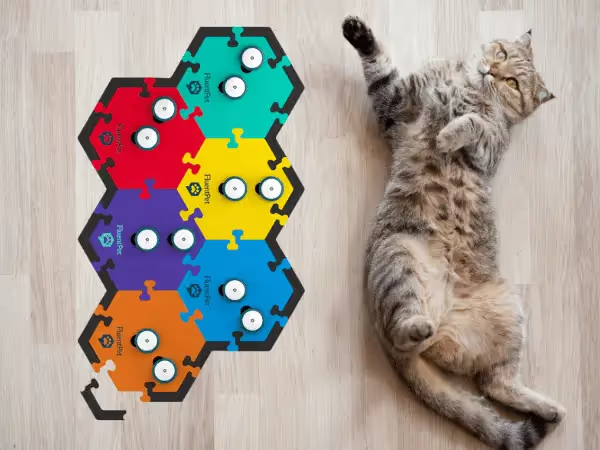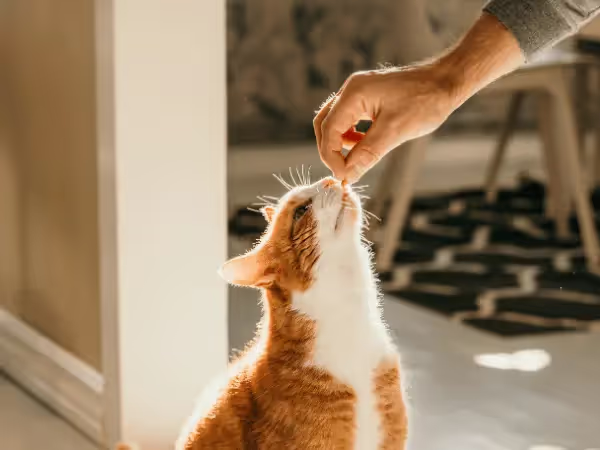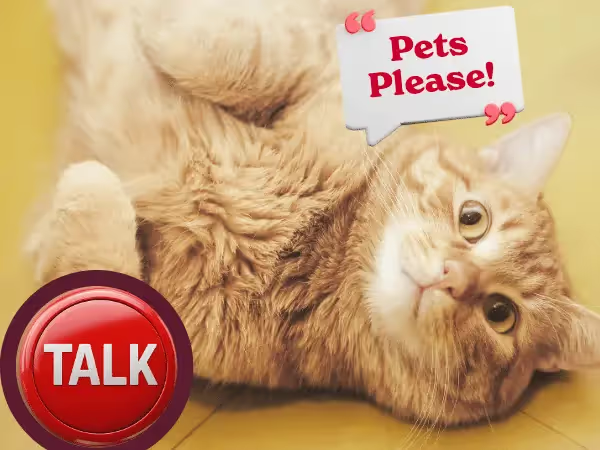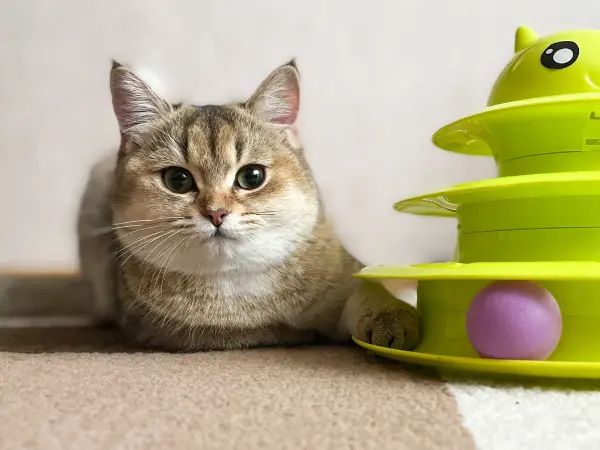If you’re like most cat parents, you are probably wondering what your cat is thinking most (if not all) of the time. They are mysterious companions and may sometimes stare, meow repeatedly, and knock over items on the table—leaving pet parents guessing why they’re doing that and most importantly, “what is my cat trying to say?”
If you’re looking to understand your cat better, this Sploot Vets article goes into how to teach a cat to talk using buttons, a trending practice among cat parents on social media.

I. Can I Teach My Cat To Use Buttons To Talk?
Yes, it is possible to teach your cat to talk using talk buttons or speech buttons. However, it might require some work, depending on your cat’s starting point. Here are a few factors to consider:
a. Your Cat’s or Kitten’s Socialization
Kitten socialization is a process of gradually exposing a kitten to different experiences and people to help increase their confidence around people. The optimum socialization period of most kittens is between 3 to 12 weeks.
Why this matters for teaching a cat to talk: If a kitten or cat is socialized properly, they are more likely to be comfortable with human interaction, making them more responsive to training.
b. Do You Have a Strong Bond With Your Cat?
Studies show that cats form different attachment styles to their owners, depending on socialization and experiences. This highlights the importance of taking the time to bond with your cat. They remember consistent cat care, respectful affection, and fun play sessions; these influence the way they relate to you.
Why this matters for teaching a cat to talk: A stronger attachment or bond increases the likelihood of reciprocal behaviors, which can help increase a cat’s trainability.
c. Your Cat’s Breed, Disposition, & Other Individual Factors
Last but not least, a cat’s breed, disposition, and other individual factors can affect how easily they learn, remember, or desire to please their pet parents. Here are some examples of breeds that are typically easier to train and why:
- Siamese Cats - these cats are known for their strong bonds with pet parents, intelligence, and their ability to recognize human vocal cues. Some Siamese cats have been taught to do high-fives, jump through hoops, spin, and so on.
- Maine Coons – these cats have an eagerness to please, and are gentle and intelligent. Some Maine Coons can be trained to walk on a harness, roll over, and fetch.
- Ragdolls – these cats have a naturally high capacity to bond with their owners, are docile, and also intelligent. Some Ragdolls have been taught to walk on a leash or play fetch.
- Abyssinians – these cats are highly intelligent, love learning, and enjoy engaging with their pet parents. Some Abyssinians have been taught to do tricks like jumping through hoops or playing fetch.
d. Does Your Cat Communicate With You?
Your cat may already be speaking through vocalizations, meows, and feline body language. If they are already communicating with you on this level, there is a good chance this skill can transfer to using talk buttons.
e. A Cat’s Vocabulary
It is widely believed that a cat’s vocabulary may not be as extensive as a dog’s. However, cats can still associate specific words with corresponding actions, objects, or outcomes. A study states that cats can learn anywhere from 25 to 35 words. However, some cats, like Billi (the first cat widely known for learning to use talk buttons), were said to have learned over 70 words.

II. What Are Talk Buttons for Cats?
If you want to teach your cat to talk, you’d first need to get speech buttons or talk buttons for cats. These are recordable or pre-recorded sound buttons that allow cats to communicate after being trained to press certain buttons depending on what they want to “say.”. Each talk button is assigned one word or phrase.
a. Benefits of Using Talk Buttons for Cats
- Mental Stimulation & Enrichment – Using buttons challenges a cat’s cognition, offering engaging, enriching mental activity beyond toys.
- Stronger Communication & Bonding – Talk buttons help deepen the human–cat relationship by enabling clearer, reciprocal communication.
- Reduced Destructive Behavior – Expressive outlets like buttons can reduce frustration-driven behaviors by giving cats a way to signal needs.
b. How Talk Buttons for Cats Started
Speech buttons or talk buttons for cats (and dogs) are similar to AAC (augmentative and alternative communication) devices, originally designed for non-verbal individuals or people with speech impairments.
A speech-language pathologist, Christina Hunger, popularized using AAC devices on dogs in 2018 by trying them out on her dog, Stella. This became a viral sensation among pet parents.
It wasn’t long before a cat parent and veterinarian, Dr. Kendra Barker, introduced talk buttons to her cat, Billi, a 13-year-old domestic cat, in 2020. This paved the way for other cat parents to open the doors of communication, never before imagined between humans and their feline companions.

III. How to Teach a Cat to Talk with Buttons
Looking to teach your cat to talk with buttons? Follow these steps:
1. Start with 1 to 3 Cat Talk Buttons Only
Begin by getting 1 to 3 recordable or pre-recorded talk buttons for your cat. We highly recommend starting with highly motivating words such as: Food, Treats, and Play.
Put a symbol on each button using a sticker, decal, or permanent marker to help your cat remember which is which. You can also arrange the buttons on a mat to prevent misplacement and accidental stepping on the buttons
Note: There’s no guarantee that all cats will learn to use talk buttons, so it’s best to start small, especially when purchasing your first set.
2. Model the Usage of the Talk Buttons Consistently
Cats learn by observing. Therefore, the best way to teach your cat to talk with buttons is by using the buttons yourself. Each time you’re about to do a related action, press the corresponding button. Here are some examples:
- Press the button for “Food” → give them their scheduled meal.
- Press the button for “Play” → engage in interactive play with your cat.
With consistency and repetition, your cat will begin to form the association and remember what each button is for.
3. Encourage Paw Pressing & Use Positive Reinforcement
Wait for your cat to approach the talk button/s. If they accidentally press a button, immediately respond with the action and lots of praise. This helps to positively reinforce the behavior.

4. Setting Boundaries
If your cat repeatedly presses the “food” button, it doesn’t mean you need to feed them every time, especially outside their usual routine. Stay consistent and composed. You can calmly acknowledge them with a gentle response like, “Later.”
The same approach applies to other buttons like “treat,” especially if they’ve already had their daily limit.
5. Add More Buttons Slowly
Once your cat gets the hang of the first 1 to 3 talk buttons, you can introduce other talk buttons gradually. However, it is widely believed that cats have a smaller vocabulary than dogs; therefore, we recommend focusing on highly relevant words that are the most useful for you and your cat.
- Time-related statements – later, wait, now
- Requests – pets, brush, look
- Specific toys or items – mouse, tower, box, crate
- Specific treats – chicken, tuna, beef
- Names – the cat’s own name (cats know their name), your name (cats can also know their owner’s name), people in the house, other pets
- Emotions – happy, scared, sick, mad, love you, ouch
- Locations – couch, bed, kitchen, bathroom, catio, litterbox, outside
Note: As your cat’s vocabulary expands, it’s helpful to place related buttons near each other. This taps into your cat’s spatial memory, their ability to recall where things are and how they’re arranged. Thus, grouping buttons together helps make it easier for them to learn and remember.
IV. 3 Best Talk Buttons for Cats
Talk buttons for cats are available both online and in some pet stores. A few popular options include:
- FluentPet – They offer recordable, compact talk buttons for both cats and dogs, along with a customizable hex-tile system for organizing buttons. The compact size of FluentPet’s buttons and pressure sensitivity make them suitable for most cats.
- Amazon, Chewy, & Etsy – On these platforms, you may find talk buttons from FluentPet and other generic options.
- Hunger for Words – Developed by Christina Hunger, Hunger for Words offers durable, large talk buttons with both pre-recorded and recordable options. However, these buttons are primarily designed for dogs and may be too bulky for smaller cats to use. The buttons may also require more pressure to activate.
Note: When purchasing talk buttons for cats, find out if any other cat parents have left reviews and note their comments on the size of the buttons, pressure sensitivity, and clarity.
Additional Note: You can also look for buttons that have symbols, stickers, and decals to help your cat recognize the buttons more easily. Colors that are perceivable to cats (i.e., blue, yellow, green) may also help make the button more interesting and memorable for cats.
Final Thoughts & Cat Talk Buttons in Action
Ready to teach your cat to talk with buttons? With consistency and patience, you can open up a whole new way of communicating with your cat. As mentioned earlier, training cats to talk with buttons can be more challenging than training dogs—but regardless of the outcome, the experience is both fun and enriching.
Here are a few examples of cats who have successfully learned to use talk buttons:
In this video by The Dodo, Billi’s owner, Dr. Kendra Barker, explains how Billi uses talk buttons:
Up next, check out this video by Roscoesqueaks where the cat, Roscoe, alerts their pet parent about pain and discomfort, using talk buttons:
Sploot Vets: Your All-in-One Cat Vet for Health & Wellbeing
Whether your cat is tapping buttons or speaking volumes with body language, we’re here to help you decode their world and support them with the thoughtful, top-tier vet care.
Sploot Veterinary Care provides all-in-one vet care for your cat’s overall health and well-being. Whether you need a consultation for health issues, behavioral challenges, or so on, we’re always here to help!
We offer primary care, urgent care, and emergency vet services, all under one roof! We also offer daily appointment availability, 365 days a year, with extended vet clinic hours so we can be there for you when you need us most. We also offer a Fear Free vet care experience so you can be sure your cat feels safe, calm, and respected every step of the way.
Visit one of our modern vet clinics for cats in Chicago, Colorado Springs, and Denver! Easily book an appointment online or through the Sploot Vets pet care app!






